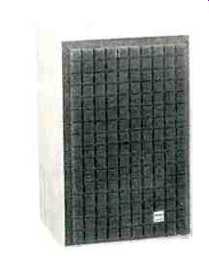
MANUFACTURER'S SPECIFICATIONS:
System Type: Two-way acoustic suspension.
Drivers: One 10-in. (25.4 cm) woofer, one 1 1/2-in. (3.8 cm) dome tweeter.
System Resonance: 42 Hz.
Crossover Frequency: 1.5 kHz.
Impedance: 8 ohms nominal.
Power Requirements: 10 watts average.
Size: 15 5/8 in. W. x 11 7/8 in. D. x 24 in. H. (39.7 x 29.8 x 61 cm).
Weight: 51 lbs. (23.1 kg).
Price: $99.95.
The Model AS201A speaker system, from GTE-Sylvania, is a two-loudspeaker design. The bass frequencies are handled by an acoustic suspension enclosure housing a 10-in., high compliance woofer, while the upper frequencies are carried by a 1 1/2-in. dome tweeter. The cabinet is of moderate size and is finished in walnut vinyl. The grille is sculptured brown foam, held in place by grip fasteners on the front panel board. The units are designed for either floor or shelf mounting.
A recessed cavity on the rear of the enclosure contains the speaker terminals and two toggle switches. The terminals are of the 5-way three-quarter inch spacing variety which allows ready hookup by spade lugs, twisted wire, or banana plugs. The plastic insulated caps on these terminals are colored for polarity identification-red for positive and black for negative. Printed next to the respective terminals are the legends Pos and Neg, so the user should have no trouble making proper connection.
Two toggle switches are mounted above the speaker terminals. One, a three-position switch, is labeled Mid Freq. and has the marking Normal, Lo, and Hi in vertical-ascending order. This may be a good technical solution for a single switch which changes the mid-frequency response in a two-way system, but it is less than perfect human engineering since the lowest acoustic position is the center switch position. The other toggle switch is better. It is a two-position High Freq. control marked Hi and Lo. Fortunately, the acoustic effect of both controls is modest, so the user cannot go far wrong.
The foam grille is massive-looking, but almost perfectly transparent acoustically. It is held to the front panel with Velcro fasteners, which allow it to be removed readily for cleaning. A Sylvania logo is fastened to the foam front in one special place with a Velcro fastener. As received, the logo was mounted for vertical speaker placement with the woofer at the bottom of the panel and the rear panel control labels upright. If horizontal shelf mounting is desired, the logo can be rotated ninety degrees, and refastened to stay upright. If you do this, be certain to make the logo appear in the upper right corner so that the tweeter will be farthest away from the shelf. This is to prevent shelf reflection from the tweeter. The panel side of the grille is hollowed to fit the slightly protruding speakers so there is only one way the grille will attach properly. Because of the weight of the AS210A only a very sturdy shelf should be used.
The AS-210-A is covered by a five-year warranty for any part which fails in normal use during this period. The warranty also covers replacement labor or service charge for the first two years.
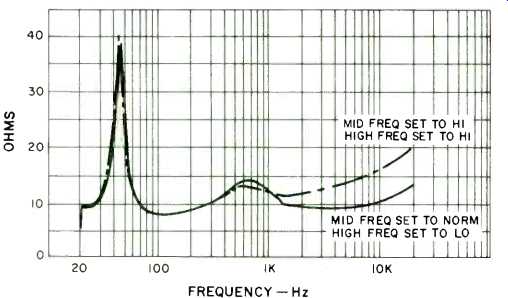
Fig. 1-Impedance.
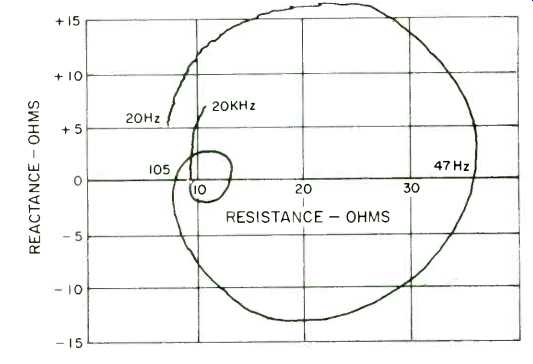
Fig. 2-Complex impedance plot.
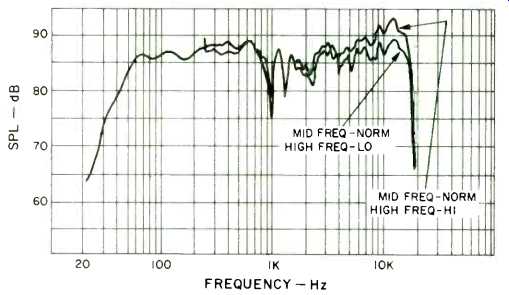
Fig. 3--One-meter, on-axis anechoic amplitude response, one-watt input.
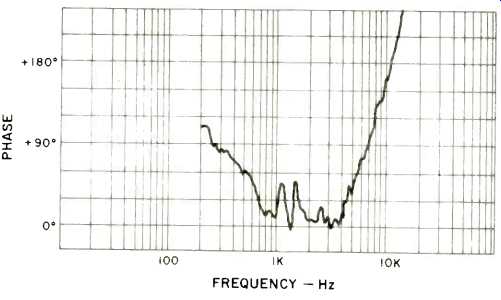
Fig. 4--One-meter, on axis phase response, corrected for acoustic position
of midrange driver.
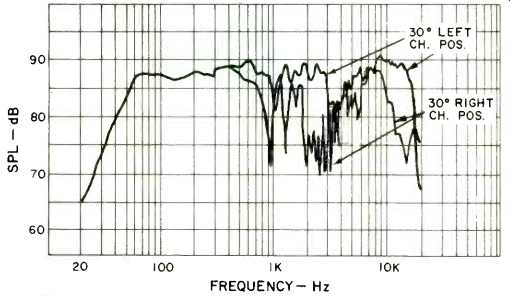
Fig. 5--One-meter anechoic amplitude response for 30° off center listening
positions.
Technical Measurements
The magnitude of load impedance which the AS210A presents to an amplifier is shown in Fig. 1 for two positions of the equalization controls. While there are six possible equalization combinations, the two shown in Fig. 1 represent the extremes, so far as the load impedance is concerned.
When it comes to impedance there is one thing you can depend upon-loudspeakers are never pure resistors. That is no fault, they do not have to look like resistors. Yet, the recent fuming and fussing about the method of testing power amplifiers for power has all but ignored the true load which the amplifier must drive--the speaker. As this reviewer has pointed out before, one can calculate a loudspeaker's complete impedance, magnitude, and phase angle, from measurement of impedance alone. That is why we show that measurement. But perhaps a better service can be provided if we also evaluate the loudspeaker as it might cause problems when used as a load for a power amplifier. Amplifiers designed to drive pure resistances may experience stomach aches when asked to drive actual loudspeakers at high level.
This is not the fault of the loudspeaker, but is certainly caused by its presence.
Figure 2 is the measurement of the complex impedance of the AS210A for the Mid Freq = Norm, High Freq = High positions of equalization. The frequency range covered is from 20 Hz to 20 kHz. Only a few frequency values are marked on this plot since Fig. 1 shows the frequency characteristic for the same data measured as magnitude.
The lowest value of impedance presented by the AS210A is slightly below 8 ohms, and is resistive. Two main resonances are shown, one of them is the characteristic resonance of a sealed enclosure (the large circular arc in Fig. 2) which peaks here around 43 Hz. The other is a midrange peak at 600 Hz. This speaker is resistive at four frequencies between 20 Hz and 20 kHz. The worst reactance load at high frequencies, where many inexpensive amplifiers experience difficulty, is a capacitive reactance of only 11 degrees phase angle near 1100 Hz. The worst reactive volt-ampere drive near bass resonance should offer no problems to any reasonably well-designed amplifier. These plots show that the AS210A offers no load problem.
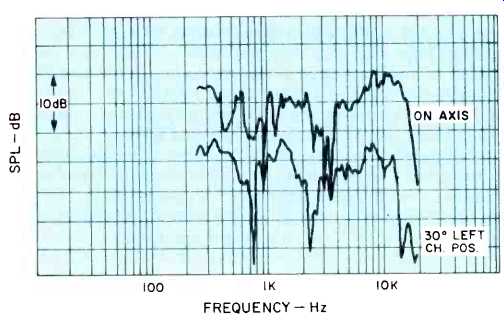
Fig. 6-Three-meter room response-speaker on floor.
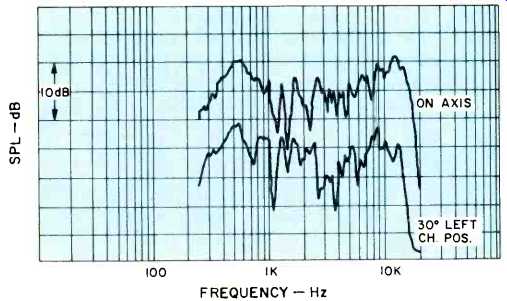
Fig. 7-Three-meter room response-speaker 24 in. above floor.
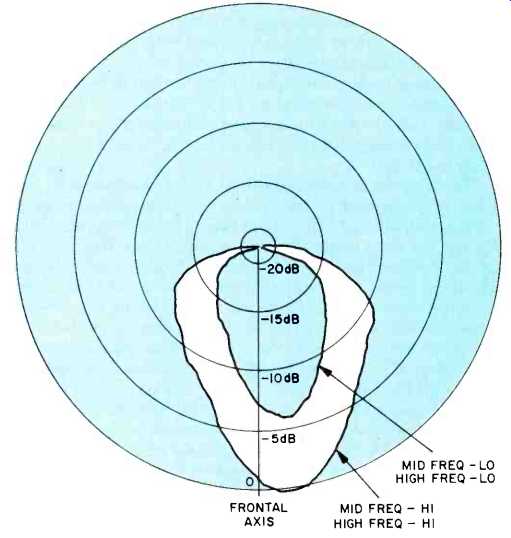
Fig. 8-Horizontal polar energy response.
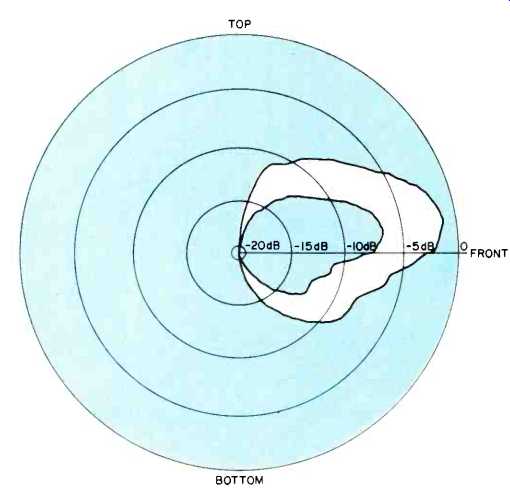
Fig. 9-Vertical polar energy response.
One-meter on-axis anechoic frequency response is shown in Fig. 3 for amplitude (SPL) and in Fig. 4 for phase.
The axial SPL is quite smooth. The low frequency response is a textbook 12 dB-per-octave rolloff below 55 Hz. Some crossover notching occurs at around 1100 Hz but the trend is smooth up to an upper limit around 18 kHz.
The axial phase response reveals that the woofer and tweeter are in phase at crossover with no sudden phase shift to mar performance. The axial response is principally minimum-phase throughout the frequency range. Above 3 kHz the tweeter has a 90 degree phase lag for this measurement.
Only one phase measurement is shown, and this is corrected for the average acoustic position in the range from 600 Hz to 3 kHz. The acoustic position from 3 kHz to 12 kHz is such that the sound reaches the ear 0.1 millisecond earlier than sound in the 600 to 3 kHz range. The sonic effect of this arrival difference usually is to emphasize speech sibilants and crispen short-duration sounds. However the magnitude of delay in this speaker on axis is so small as to be negligible.
There is a distinct off-axis effect that deserves some notice. The best frequency response occurs directly in front of the AS210A. When the speakers are placed in a right channel and left channel stereo position, however, the anechoic response is not as smooth, as can be seen in Fig. 5. With the speaker rotated so that its axis falls to the right of the listener (right channel stereo position), the unit is distinctly non minimum phase. In the frequency range from 1100 Hz to 2100 Hz the 30-degree right channel position has a non minimum phase transition of 1440 acoustical degrees lag.
Even a 10-degree angle offset from the on-axis position provides a 720-degree acoustic phase transition. This indicates that the best sound will be obtained with the speakers angled directly toward the listening position.
The three-meter room response is shown in Figs. 6 and 7.
These measurements are the Fourier transform of the first 13 milliseconds of the loudspeaker's impulse response. They show the characteristic timbre for "early" sound in a normal listening situation.
The listening test revealed that an off-floor speaker position, as suggested in the instructions, provided more accurate sound than floor mounting. Figure 6 shows the response for floor mounting flat against a back wall. The data of Fig. 7 shows the response with the AS210A raised 24 inches off the floor, placing the center of the speaker at ear level, approximately one meter above the floor. The off-floor response may be seen to be distinctly superior. And as in the anechoic measurements, the on-axis response is better than that off-axis. I definitely recommend rotating these speakers in toward the listening area. The equalization used for all of these measurements was Normal for mid-frequency and High for high-frequency switch positions.
The polar energy response is given in Fig. 8 for the horizontal direction and in Fig. 9 for the vertical direction. Two extreme equalizations were used for the polar tests. In one case both mid-frequency and high-frequency switches were set to Low, and in the other both were set to High. It is obvious from Fig. 8 that there is a distinct left-channel sound superiority that verifies the anechoic and room test measurements. This measurement shows that a substantial amount of sound will be reflected off the back wall if the speakers are rotated toward the listening area while placed against that back wall. In some listening rooms this might give a stage-filling spread of sound pleasing to some ears, but not so realistic to others. To minimize this effect it may be necessary to experiment with the speakers pulled away from the wall. The broad horizontal dispersion of frequencies indicates that large reflecting objects, such as book cases, should not be placed next to the AS210A if they extend past the front of the enclosure.
Harmonic distortion for the musical tones of E1 (41.2 Hz), A2 (110 Hz), and A4 (440 Hz) is shown in Fig. 10. This distortion, though not spectacularly low, stays at quite acceptably low levels, generally below 1% through the usual listening range.
Intermodulation of 440 Hz by 41 Hz is shown in Fig. 11 as a function of drive level. There are about equal amounts of phase and amplitude modulation on A4 caused by E1. At 10 watts the amplitude modulation is 4% peak-to-peak and the phase modulation is 6 degrees peak-to-peak. At 40 watts there is 8% amplitude modulation and 10 degrees phase modulation. These are both principally 41 Hz modulations.
In the crescendo-handling test, incoherent noise of 80 volts peak-to-peak magnitude caused a one-half dB drop on a very low level A4 inner musical voice while barely suppressing a middle C voice. It can be concluded that applause and hand claps will not cause significant modulation of low level musical passages when the AS210A is driven within its power rating. Both A2 (110 Hz) and middle C (262 Hz) are one-half dB softer at 20 watt drive level than they should be based on the acoustic gain of each at the 0.1 watt drive level.
Sudden loud passages may therefore cause a tiny lateral spread of musical voices in the stereo image for those left of-center or right-of-center sounds which have more of their energy in one channel. This effect is virtually nonexistent below 1 watt and at normal listening levels.
The energy-time curve of Fig. 12 is very good for a speaker in this price range. This is the envelope of the impulse response computed for a one-meter on-axis position. The major sound energy arrives at 3.0 milliseconds, with very small reverberant and diffractive scattering arriving after that time. Integration of this data reveals that 95 percent of the sound energy arrives within 3.1 milliseconds and 99 percent arrives within 3.4 milliseconds. The only late straggler (arriving at 4.6 milliseconds) is due to enclosure-boundary diffraction, and that is almost 30 dB down. The dominant frequency for the first sound arrival is in the 10 kHz range.
Therefore record ticks and scratch might be accentuated to a small extent.
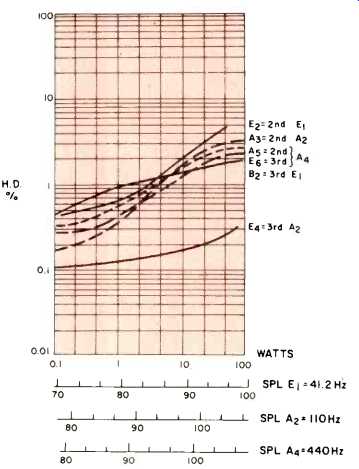
Fig. 10--Harmonic distortion for musical tones E1 (41 Hz), A2 (110 Hz),
and A4 (440 Hz).
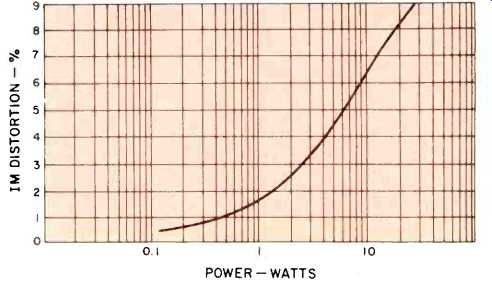
Fig. 11--Distortion of A4 (440 Hz) by E1 (41 Hz), mixed 1:1.
Listening Test
Two listening positions were chosen for auditioning the In one position the speakers were placed flat wall and raised off the floor so as to be nearly ear AS210A, against a height for a listener who is seated. In the other listening position the units were placed on the floor, slightly away from the back wall. The stereo listening angle was about 60 degrees for both positions.
From the standpoint of overall sonic balance of the midrange and upper frequencies the better of the two positions is the raised, wall-mounted location. However the bass frequencies appeared to my ears to be too strong when the speakers were against the wall. The floor position reduced this bass dominance but did so at the expense of midrange clarity. The AS210A, in my opinion, needs all the midrange level you can get from conventional tone control equalization. This is because of the strong bass (200 Hz and below) which tends to overwhelm the midrange frequencies even with the mid frequency equalization in the Hi position. The very highest frequencies, carried by the tweeter, can be brought up to the level of the bass frequencies with the tweeter control in Hi. Even with a Lo tweeter control setting on the AS210A and conventional tone control boost, the midrange appears to lack punch.
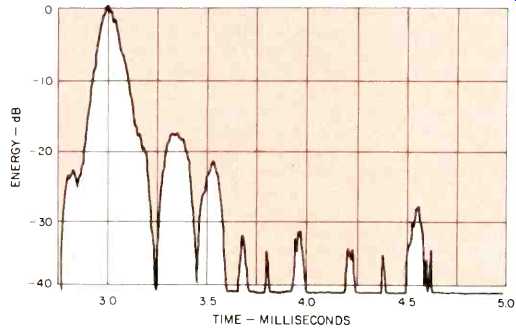
Fig. 12--Energy-time response.
The bass heaviness of this system, coupled with the robust high frequency response, may constitute sound that is pleasing to a great many listeners. I am not one of them. I must admit that classic pipe organ sounds very good on this system and creates a good, space-filling illusion. Vocals and percussion bass instruments did not appear as accurate to my ear.
Stereo localization is moderately good with this system, with a slight tendency for lateral spreading of some stereo instruments. For those instruments which contain most or all of their energy in the frequency range of the tweeter, the sound is darn good. The tweeter is, in fact, the star performer in this loudspeaker system. The articulation and transient performance of the tweeter is excellent.
The AS210A is not a speaker system that I can recommend as a primary stereo system for a very large room. There are, however, several applications where the sound qualities of this speaker can be put to good use. One is as the important rear speakers of a quadraphonic installation. The distribution of sound energy may complement that of some of the higher quality systems one might use for the front. A second application is that of low-cost stereo speakers for a very small room, as in many college dormitories, where the bass response of many systems often sound anemic. The AS210A should shine in that environment.
--Richard C. Heyser
(Source: Audio magazine, Aug. 1975)
Also see: ESB 7/06 Speaker (Nov. 1983)
= = = =